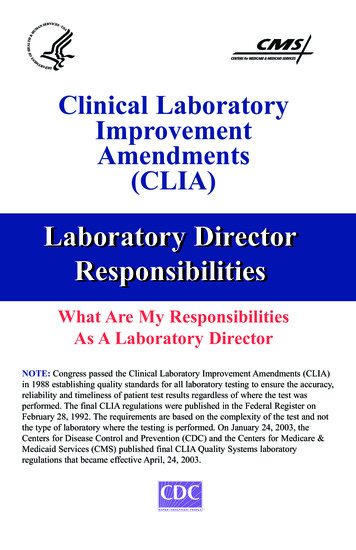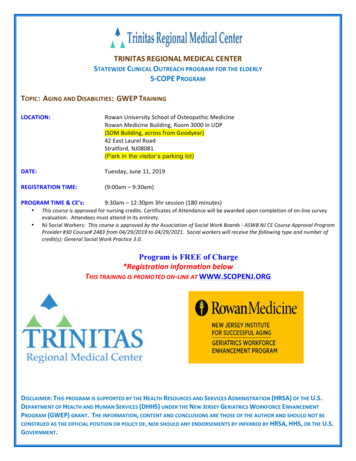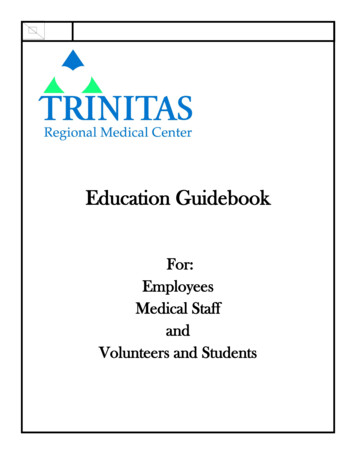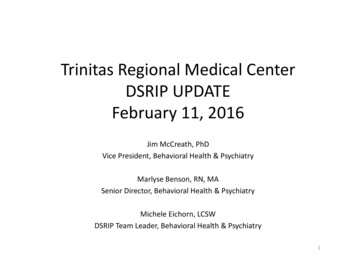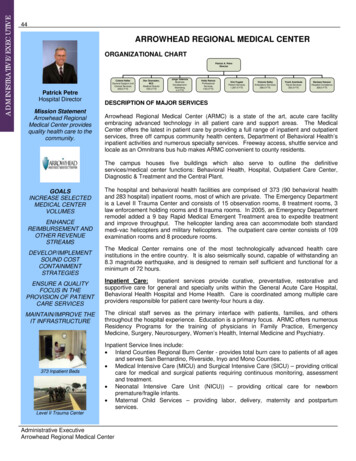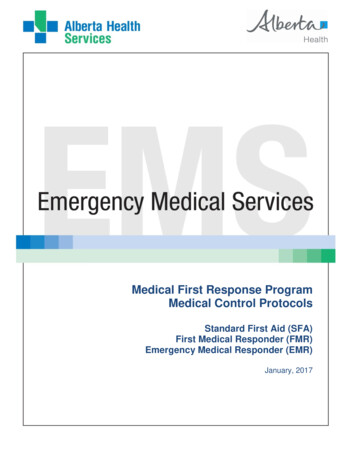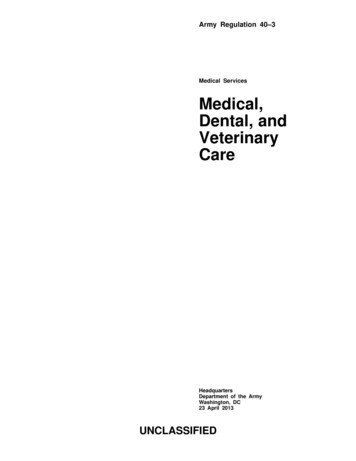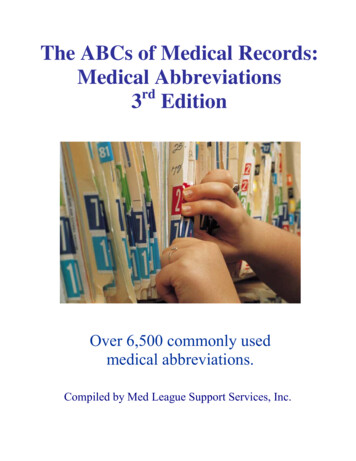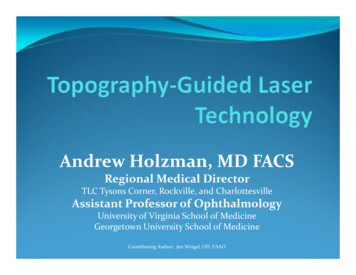
Transcription
Andrew Holzman, MD FACSRegional Medical DirectorTLC Tysons Corner, Rockville, and CharlottesvilleAssistant Professor of OphthalmologyUniversity of Virginia School of MedicineGeorgetown University School of MedicineContributing Author: Jen Weigel, OD, FAAO
Disclosures I have no financial interest in the following subjectmatter.
Current Excimer Laser Technology AMO VISX STAR S4 IR excimer laser Advanced CustomVue procedureNo longer at any TLC Center Alcon WaveLight EX500 excimer laser Currently the excimer laser platform of choice for all TLCCenters across North AmericaI was using this platform long before TLC followed my lead
VISX STAR S4IR ExcimerLaser ** We no longer usethis laser system.
More Detailed Information Wavefront technologywas originally developedfor use in high poweredtelescopes to reducedistortions when viewingdistant objects in space. This technology has beenapplied to laser visioncorrection.
Precision Identifies and measuresimperfections in anindividual’s eye 25 times moreprecisely than standardmeasurements for glasses andcontact lenses.
Hartmann-Shack AberrometerCCDImageOutcoming WaveCCD-Camera Lens Array
WaveScan WaveFront System 240 Hartmann-Shack data points analyzed AMO Fourier algorithm provides high resolutionanalysis of the wavefront error Equivalent to 20th order Zernicke measurement
Advanced CustomVue The marriage of theWaveScan Systemand the STAR S4 Excimer LaserSystem
Key Points Concerning CustomVue Technology Able to treat aberrations that were previously unmeasurable Each eye has its own unique “fingerprint”, which can be measuredand treated Better chance of achieving “personal best vision” Minimizes any potential night time aberrations. Larger pupils (7.5 mm or more) were among most satisfied groupof patients! Iris registration increases alignment accuracy and precision
AMO RefractiveLaser Suite:IntraLase VISX STARS4 IR Excimer Laser
AlconWaveLightEX500 ExcimerLaser ** We offer this lasersystem at TLC TysonsCorner, Rockville, andCharlottesville.
Why is the WaveLight EX500 different? Fastest laser in the United States today Features technology that accurately controls thecreation and precise delivery of every single laser pulse Uses wavefront principles right from the start andallows customization of the standard treatment
How fast is the WaveLight EX500? 500 Hz repetition rate Ablates 1D tissue in 1.4 sec Increased speed means decreased: Stromal dehydration Flap shrinkage Sensitivity to eye movements Patient fixation fatigue
Ablation with WaveLight EX500
Wavefront-Optimization Based on empiric research, WaveLight developed analgorithm that adds additional pulses into theperiphery to pre-compensate for the induction ofspherical aberrations in the periphery
Peripheral Pulse Control In the periphery of the eye, the laser pulse hits thecornea at an angle Due to the angle of incidence, light is partiallyreflected away from the eye This results in energy losses up to 80% If losses are not compensated for, post- op ablationprofile does not match the natural corneal shape
Peripheral Pulse ControlA circular beamIs being projectedOn the corneaNormal ablationReflectionCircular in the centreReduced Ablation, lowFluence
Peripheral Pulse Control Reduces induced spherical aberration andsecondarily reduces the incidence of post opnightime glare. Larger optical zones with a more prolate post opcorneal shape.
Large, true optical zonesBlue effectiveoptical zoneGreen transitionzone
Controlling thermal load Thermal-Optimized Shot Distribution Varies the distribution of shots to minimize overlap Only every 5th shot overlaps with the first in the series Reduces thermal load1 5342
Eye Tracking System 1050 Hz multi-dimensional eye tracker synchronizedat 500 Hz Movement tracking with only 2 ms latency Dynamic pupil tracking from 1.5 mm to 8.00 mm
AlconWaveLightFS200/EX500RefractiveLaserSuiteNemo helps keeppatients calm in sx
New Excimer Laser Technology:Topography-Guided Treatments First introduced 2002-2003 “Topography-based ablation profiles allow cornealregularization with respect to an assumed idealcorneal surface while correcting refractive error byincorporating the manifest refraction into thetreatment algorithm.”From Tan, et al. Clinical Results of Topography-based Customized Ablations for Myopia and Myopic Astigmatism. JRS, Vol 28, No 11, 2012.
Visual Aberrations Optical irregularities that can reduce quality of vision: Lower-order aberrations Myopia, hyperopia, astigmatism Higher-order aberrations Coma, trefoil, spherical aberration Aberrations of the visual system result in, most commonly: Blur Glare Halos Diplopia Difficulty with night vision
Wavefront-guided vs Topo-guided Wavefront-guided systems measure the aberrations ofthe ENTIRE visual system Cornea, lens, retina All of these aberrations are compensated for on thecornea with a wavefront-guided excimer laser Could potentially create a more irregular cornea aftertreatment, if the lens and retina contribute the majorityof aberrations
Wavefront-guided vs Topo-guided Topo-guided systems measure the aberrations of thecornea only– Treatment seeks to smooth out the corneal surface and createsymmetry Reduces corneal irregularities which accounts for 90% ofhuman visual aberrations Advantages over wavefront-guided measurements Covers larger area of corneaNot affected by pupil sizeNot affected by accommodative statusMore reliable than wavefront measurements on highly abberatedcorneasDoes NOT put all of the eye’s aberrations onto the cornea Cataract surgery implications
Wavefront-guided vs Topo-guided Topo-guided uses combination of myopic andhyperopic treatments based on the topography--- thisapproach yields better visual results AND removes lesstissue. Tissue sparing is key advantage as highly aberratedeyes treated with Wavefront require a lot of tissueremoval. Topography is more reproducible than a Wavescansince pupil size and accommodation aren’t variables.
Topo-guided refractive treatments Corneal topography gives no information about thespherical or astigmatic error of the eye, so topo-guidedtreatments cannot be based just on topography! Software is needed which combines the topo and therefractive information together to generate the patternon laser shots that will improve the vision.
Alcon FDA Approval FDA approval of Alcon system – 09/27/2013 Three-part system to achieve topo-guided treatment AllegrettoWave Eye-QExcimer Laser AllegroTopolyzerVario topo-guidedCustomAblationTreatment (TCAT) planningsoftwareAll of my TLC Centers – Tysons Corner, Rockville, and Charlottesville – are nowoffering topography-guided laser technology. We were selected as pre-launch centers.
Allegro Topolyzer Vario Similar to how the WaveScan feeds information into theVISX excimer laser system Placido disc system Placido disc system with 22,000 elevation points - standarddeviation of 3 microns on a 1200 micron elevation Highly accurate digital system - accounts for pupil shifts,cyclorotation . Has a REFRACTIVE MAP – highlights aberrations of thecornea and their influence on the refractive state. Feeds topographic info directly into the EX500.
Topolyzer VarioPhotos by Lori Kranz, COA
Topolyzer Vario Can be used to analyze corneas for topo-guidedtreatment Learning curve for technicians in obtaining scans Very tear film dependent Harder to obtain on those with prominent brow/deepset eyes, larger nose Requires variable positioning of the patient’s head
Vario Overview Screen
Pupil and Limbal RecognitionConfirmation
Poor pupil recognition
Poor pupil recognition
Poor limbal recognition
Image area vs OZ sizePoor tearfilm qualityleads todistortionsin the pt’stopography
Tear filmdependent With a good tear film,the mires are perfectlysymmetrical Similar to manualkeratometry
Tear filmdependent With a poor tear film,the mires are distortedin dry areas
Compare examinations
Compare examinations
Contoura Vision Officially announced at American Academy ofOphthalmology meeting – November 15, 2015 Awaiting commercial launch for topo-guided forMarch 2016 Allows use with EX500
Topo-guided Treatment Parameters For topo-guided treatment: At least 18 years of age or older Official FDA approval is for “normal” corneas Spectacle prescription of: Up to -8.0 D myopiaUp to -3.0 D astigmatismUp to -9.0 D SE myopia with astigmatismStable rx for the last year Not yet for hyperopes or mixed astigmatism
Custom Ablation Treatment (T-CAT) Proprietary software to develop topography-guidedtreatment Creates large uniform optical zones Removes more tissue vs wavefront-optimized ablation Could be used for (as off-label treatment): Previous decentrations Increase small optical zones Irregular ablations from previous treatments Post-RK cases Post-keratoplastic cases Asymmetric bow-ties that might still be “normal”
Alcon Topo-Guided Clinical Study Prospective, non-randomized, multi-center, phase IIIstudy 10 study sites across the US Objective: Evaluate safety and effectiveness ofWaveLight topo-guided system for treatment of Manifest refraction HOA and asphericity Based on corneal topography data
Alcon Topo-Guided Clinical Study Adverse Events Total of 6 adverse events reported 4 transient/temporary decrease in vision withresolution by end of study 1 decreased vision secondary to blunt force trauma onday 4 post-op 1 RD, not related to surgical procedure
Alcon Topo-Guided Clinical Study 3-month post-op data 99.2% - UCVA 20/40 or better 92.7% - UCVA 20/20 or better 65% - UCVA 20/16 or better34% - UCVA 20/12.5 or better
Alcon Clinical Study: UCVA
Alcon Clinical Study: BSCVA
Alcon Clinical Study: Visual Sx
Alcon Topo-Guided Clinical Study 3-month post-op “marked” or “severe” visual symptom with incidence 5% at one-month post-op Dryness 7% at one-month vs 4% baselineLight sensitivity 7% at one month vs 5% baseline “marked” or “severe” visual symptom with incidence 5% at three-month post-op: None
Alcon Topo-Guided Clinical Study “Traditional” LASIK symptoms like glare/halos,difficulty with night driving, light sensitivity, anddryness improved after topo-guided treatment Confirmed by questionnaires at 6-12 months post-op Continued improvement with time
Post-op reporting is important We track all of our results using a software programcalled IBRA In order to enter data, we need the following from you: For 1-month and 3-month post-op UCVA OD and OS MR OD and OS even if your patient is 20/20 UCVA! BCVA OD and OS Incomplete data sets do not allow us to track dataproperly!
Our TG results (n 12 of 52) 12 complete data sets out of 52 possible TG patients Send in your post-op reports so our data betterrepresents whatour patients areactually getting and seeing!
WFO vs TG resultsBelow: Contouraresults based on 12 (of32 possible) cases.Above: WFO resultsbased on 751 (of 1832possible) cases.
Nidek EC-5000 Excimer Laser Received FDA approval for topo-assisted treatment on09/30/2013 – just 3 days after the WaveLight approvalNidekEC-5000ExcimerLaser RefractivePower/CornealAnalyzerOPD – ScanIII CustomAblationSoftwareFinal Fit
Nidek EC-5000 Excimer Laser For topo-assisted treatment: At least 21 years of age or older Spectacle prescription of: Myopia between -1.0 to -4.0 DAstigmatism between -0.5o to -2.0 DUp to SE between -1.0 to -5.0 D
Goals for Topo-Guided Treatments Reduce irregular astigmatism Creates a more regular corneal surface Make the cornea more symmetrical with respect to the visualaxis Improve previously-reduced BCVA Not necessarily to improve UCVA Sometimes may have to reduce UCVA to improve overallquality of vision (ie, enlarging an optical zone) Secondary correction could then be used to improve UCVA Improve quality of vision
Topo-Guided Software Interprets data from topographerCombines myopic and hyperopic treatment profilesConstructs topo-guided laser ablation profileParameters can be modified Optical zone Depth of treatment Refractive error Attempts to Flatten the steepest part of the cornea Steepen the flattest part of the cornea While removing less tissue vs Custom tx(which only seeks to flatten the cornea)Bimodal tx saves asmuch as 1/3 tissue vsWG tx
Topo-Guided Treatment of: KCN PMD Ectasia Other Post-LVC complications Central island, decentered ablation, small opticalzone, induced irregular astigmatism Post-RK Other causes of irregular astigmatism PKP, lamellar keratoplasty, LRI, corneal scars
Preparing for TG PRK: LargeCentral K Scar 19 yo male seeks entryinto Coast Guard Childhood injury resultsin large central scar w/resultant topo PLAN: Topo-guided PRK
Patient is stable in 2016 Patient returns in May2016 to see if he can qualifyfor topo-guided PRK OS Pentacam looks stable OS MR is -1.50-1.00x180 20/20
Vario interpretation is moredifficult on irregular cornea Vario overviewscreen OS Irregular toposecondary to Kscar
Vario interpretation is moredifficult on irregular cornea Vario compareexaminationsScreen OS
Example: Decentered/Irregular Ablation PRK elsewhere- Hyperope 2-yr post-op UCVA 20/30 OD, OS 1.25-1.00x050 20/25 1.00-1.00x060 20/25 PLAN: Topo-guidedPRK enhancementODOS
Example: Small Optical ZonePre-opPost-opDifferenceFrom Tan, et al. Clinical Results of Topography-based Customized Ablations for Myopia and Myopic Astigmatism. JRS, Vol 28, No 11, 2012.
Corneal Topography Multiple consecutive maps should be obtained– look forconsistency and reproducibility In Alcon studies, they found that having 4 cornealtopographies that met the following criteria gave bestoutcomes: Analyzed area greater than 68% Coverage of 3 mm in all directions without artifacts Pupil tracking – software properly IDs pupil border Pupil diameter/shape – Are they consistent across all scans? Repeatability – Using difference map function for all fourscans, elevation maps within diameter of pupil should bewithin 1.00D.
Corneal Topography Be mindful of epithelial conditions that canmasquerade as ectasia/irregular astigmatism Not all topographical irregularities should be treatedwith stromal remodeling.
Conditions that May MimicKCN/Ectasia on Topography Corneal irregularities EBMD Corneal scarring SPK Salzmann nodular degeneration Amiodarone keratopathy Post-operative complication Corneal haze Epithelial ingrowth
EBMD PseudokeratoconusFrom Stein, Raymond.Topography-Guided PRK.CRST July 2014.
Post-PRK Corneal Haze Mimics Ectasia
Topo-Guided Laser as PrimaryTreatment Initially, topo-guided lasers used as a secondarytreatment only BUT is also used as primarytreatment. Alcon FDA approval is for primary treatments.
Future Uses: TG-PRK CXL TG-PRK For the stable KCN patient, the addition of TG-PRK canenhance vision Still need to use sRx or contact lenses for best vision Stromal laser ablation limited to 50-um range Leaves enough thickness for subsequent CXLMinimizes risk of more ectasia? CXL Primarily to prevent progressive ectasia Can decrease irregular astigmatism Can improve BCVA
Future Uses: TG-PRK CXLBCVA improvedfrom 20/80 to20/25.BCVA improvedfrom 20/60 to20/25.From Stein, Raymond.Topography-Guided PRK. CRSTJuly 2014.
Future Uses: ICRS PRK/CXL Intracorneal ring segments have been shown tostabilize keratoconus and improve corneal shape Flattening of cornea, some vision improvement Topo-guided PRK treatment Goal: Reduce irregular astigmatism treat part ofrefractive error Amount of vision correction limited to suggestedmaximum of 50 um stromal ablation Minimizes tissue ablation and risk of iatrogenic ectasia
Future Uses: ICRS PRK/CXL When studied as a three-step process (ICRS then CXLthen topo-guided PRK) and as a two-step process(ICRS then combined PRK/CXL), results showedimprovement in: UCVA BCVA MRSE Steep and flat K values
Future Uses: ICRS PRK/CXLCoskunseven, Efekan, et al. Topographyguided Transepithelial PRK after ICRSImplanation and CXL. JRS. Vol 29, No 1,2013.Pre-opPost-ICRSPost-CXLPost-PRK
Future Uses: ICRS PRK/CXLPre-opPostICRSPostTGPRK CXLAl-Tuwairqi, W, et a. ICRS Followed by Same-DayTG-PRK CXL in Low to Moderate KCN. JRS. Vol29, No 1, 2013.
How To Choose Laser Technologies
Patient selection for topo-guided Irregular corneas with reproducible topography Regular corneas with good correlation between the topographicand manifest cylinder. Patients with large angle kappa. (most lasers center ablation onthe pupil, topo-guided ablations are centered on the visual axis) Excellent for hyperopes as they all seem to fixate off pupil center(once hyperopic rx approved). Key is having good topographic images! (garbage in/garbageout!)
KAMRA on Good Morning America
Patient DS 24yo male MR:OD -6.75 DSOS -7.00 -0.75 x 115 Pach:OD 551 um K’s:ODOS20/2020/20OS 566 um43.9 @ 045 / 44.6 @ 13543.7 @ 022/ 44.4 @ 112
Consult scans: No days out of CLs
Consult scans
Preop scans: d/c CLs x2.5 wks
Preop scans
Anterior Curvature Map ODPre-opConsult
Anterior Curvature Map OSPre-opConsult
Vario
Vario
Vario
Vario
Summary of DS WFO treatment OD, TG treatment OS 1 day post-op: 20/20 2 OD, 20/20 2 OS, 20/15 OU 1 month post-op: 20/15 OD, 20/15 OS, and 20/15 OU MR:plano DS20/15plano DS20/15
Wavefront-guided vs Topo-guided Wavefront-guided systems measure the aberrations of the ENTIRE visual system Cornea, lens, retina All of these aberrations are compensated for on the cornea with a wavefront-guided excimer laser Could potentially create a more irregular cornea after treatme
